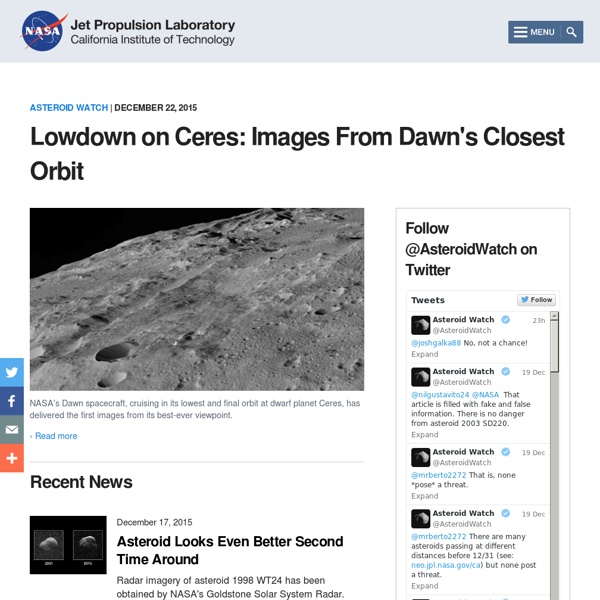ROSAT Re-entry
ROSAT (short for Röntgensatellit, in German X-rays are called Röntgenstrahlen, in honour of Wilhelm Röntgen) is a defunct German Aerospace Center-led satellite X-ray telescope, with instruments built by Germany, the UK and the US. It was launched on 1 June 1990, on a Delta II rocket from Cape Canaveral, on what was initially designed as an 18 month mission, with provision for up to 5 years of operation. ROSAT actually operated for over 8 years, finally shutting down on 12 February 1999. ROSAT is expected to re-enter the Earth's atmosphere between October 21 and 23 2011. In February 2011, it was reported that the 2,400 kg satellite was unlikely to burn up entirely while re-entering the earth atmosphere due to the large amount of ceramics and glass used in construction.
Top 10 Cool Facts about Space
Space There is still so little known about outer space by modern science, but of that little we do know, there are some extraordinarily amazing things. This is a list of the top 10 cool facts about Space. 10.
Tour Dwarf Planet Ceres And See What The Dawn Spaceraft Spots In This Alien World [Video]
NASA released a new video that offers viewers a virtual tour of the dwarf planet Ceres and its strange features including the mountain dubbed "The pyramid" and the mysterious bright spots located at the crater Occator.(Photo : NASA/JPL-Caltech/UCLA/MPS/DLR/IDA) NASA released a new video that offers viewers a glimpse of the diverse and dramatic surface of the dwarf planet Ceres. The new Ceres video tour, which was uploaded on YouTube Wednesday, was compiled from images that were gathered by the Dawn spacecraft that currently orbits the alien world from a height of around 1,200 miles, the closest the probe has gotten to Ceres.
Oil Investors at Brink of Losing Trillions of Dollars in Assets. Gore: It's That Road Runner Moment
Climate: Now or Never A major threat to fossil fuel companies has suddenly moved from the fringe to center stage with a dramatic announcement by Germany’s biggest power company and an intriguing letter from the Bank of England. A growing minority of investors and regulators are probing the possibility that untapped deposits of oil, gas and coal -- valued at trillions of dollars globally -- could become stranded assets as governments adopt stricter climate change policies. The concept gaining traction from Wall Street to the City of London is simple. Limits on emissions of carbon dioxide will be necessary to hold temperature increases to 2 degrees Celsius, the maximum climate scientists say is advisable. Without technologies to capture the waste gases from combusting fossil fuels, a majority of known oil, gas and coal deposits would have to stay underground.
Visualization Explorer for the iPad - Home
The NASA Visualization Explorer features visualizations, animations and images of our sun and the universe. Story topics include findings from NASA spacecraft exploring Earth, the planets and beyond. World premiere content delivered right to your fingertips produced exclusively for the NASA Visualization Explorer app.
Scientists Unravel Mystery of Bright Spots on Dwarf Planet Ceres
Scientists have finally cracked the mystery of the unexplained lights on the dwarf planet Ceres that were speculated to be everything from alien cities to ice volcanoes. After months of research gathered from the Dawn spacecraft, two new studies published in the journal "Nature" are shedding new light on what the 130 bright spots observed on Ceres could be and the surprising place where the dwarf planet may have formed. In the first study, scientists determined those unusual areas of brightness are likely deposits of a salty substance comprised of magnesium sulfate, similar to epsom salt on Earth. The deposits were likely left when water-ice sublimated, scientists said.
WFCAM Science Archive
UKIDSS Galactic Plane Survey (GPS) Mosaic - DR7 The main window below displays a 6 billion pixel (1 arcsec pixels) mosaic of the GPS (centre: l=52, b=0 (109 > l > 0 ,360 > l > 355 and -2.5 < b < +2.5). Use the controls in the main window or the mouse (click&drag ) to move around the image and zoom in and out. Click on the small images on the left to move to that point in the mosaic.
Worlds in Collision - The Velikovsky Encyclopedia
Core ideas Velikovsky explains that: "I came upon the idea that traditions and legends and memories of generic origin can be treated in the same way in which we treat in psychoanalysis the early memories of a single individual. I spent ten years on this work. I found that the collective memory of mankind spoke of a series of global catastrophes that occurred in historical times. I believed that I could even identify the exact times and the very agents of the great upheavals of the more recent past.
Latest Mars Weather
Captioned Image Release No. MSSS-321 — 16 April 2014 Martian weather between 7 April 2014 and 13 April 2014: The MARCI acquires a global view of the red planet and its weather patterns every day.
Astronomy Picture of the Day
Discover the cosmos! Each day a different image or photograph of our fascinating universe is featured, along with a brief explanation written by a professional astronomer. 2016 April 15 Mercury and Crescent Moon Set Image Credit & Copyright: Miguel Claro (TWAN, Dark Sky Alqueva) Explanation: Innermost planet Mercury and a thin crescent Moon are never found far from the Sun in planet Earth's skies. Taken near dusk on April 8, this colorful evening skyscape shows them both setting toward the western horizon just after the Sun.



